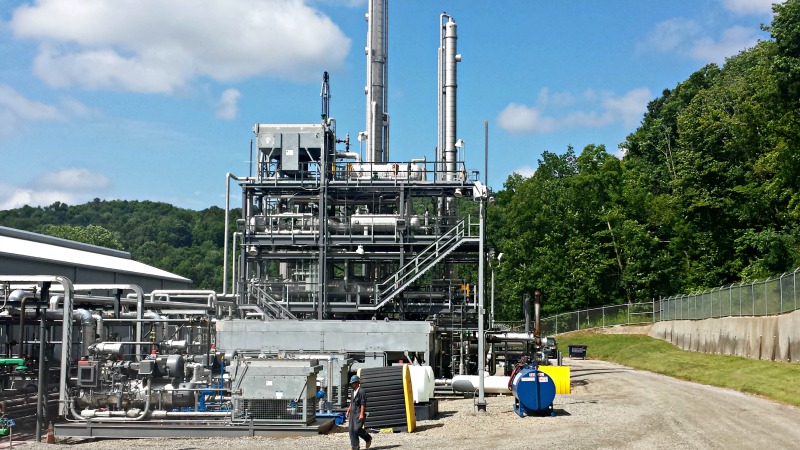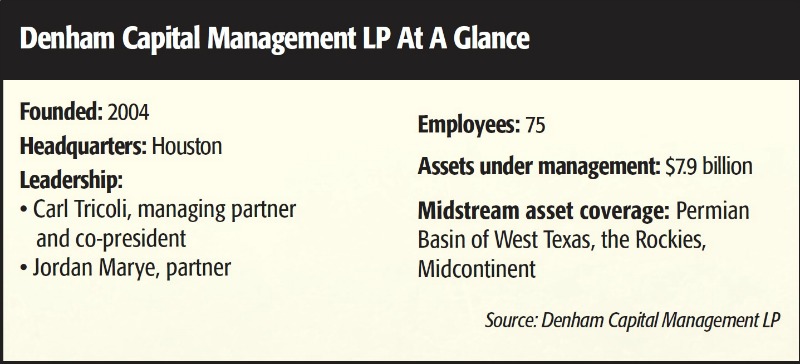
Carl Tricoli, co-founder, left, and partner Jordan Marye discuss Denham’s oil and gas investment strategy. Source: Denham Capital Management Inc.
Born of three distinct business lines within the energy space a decade ago, Denham Capital Management LP still advises clients looking to invest in oil and gas, mining and power. But co-founder Carl Tricoli has been in the business long enough to see booms and busts, and he reckons that the game-changing magnitude of the shale revolution presents opportunities for the midstream that haven’t been seen in years.
After the days of big spending began to wane in the 1980s, many of the major oil companies began divesting their U.S. assets in favor of more exotic, less-explored locales. Private equity, in fact, emerged as a player in the space to fill the funding gaps when the majors decided to sell, Tricoli said.
“Back in the day, in the late ’80s and early ’90s, private equity funds were typically $2 million to $5 million,” he told Midstream Business. “An $800 million private equity fund for oil and gas would be huge. And typical investments in a portfolio company would be between $20 million and $25 million. At that time, $50 million would be a huge investment. Now, it’s rare we commit less than $200 million to an individual company just because the scale of what’s needed today is so large.”
The “acquire and exploit” strategy gave rise to companies such as XTO Energy Inc., Apache Corp. and Devon Energy Corp., he said. And it was during this period, when conventional wisdom said the U.S. had tapped most of its hydrocarbon opportunities, that the midstream space also seemed built out to meet existing needs. Deregulation gave some heat to the sector in the 1990s when companies like Western Gas Partners LP and MarkWest Energy Partners LP formed to buy the midstream assets of the major integrated companies, he said.
“But mostly you had an infrastructure system that was built out,” he said.
As such, emerging resource plays in parts of the country that never before had a hydrocarbon bounty are defining the need for private equity in the midstream space, Tricoli said.
Marcellus midstream
“Prior to developing the Marcellus—they had been producing gas in Appalachia since the 1800s, but the gathering systems were like garden hoses laying on the ground, for these were very shallow, very low deliverability gas wells,” he said. And all of a sudden in the Marcellus they were drilling 10 million cubic feet (MMcf) to 12 MMcf/d wells, he said. “And there was nothing—literally nothing—in terms of gas infrastructure.”
The situation was repeated at gas plays across the country: Fayetteville, Haynesville, Utica. On the oil side, things perked up in the Eagle Ford, the Bakken and the Permian Basin, and those hydrocarbons needed movement.
“What these resource plays have done is completely change the nature of the midstream business because of all this increase in production. It was not just an increase in production; it was increases in production in places that historically weren’t big producers,” he explained. “Who would’ve thought Pittsburgh was going to be an oil and gas town?”
But those with some answers could see the investment opportunities in those untapped markets.
Jordan Marye, partner at Denham, explained the Denham philosophy toward midstream investment.
“We think the midstream industry is a very exciting place to invest. We also think it’s very competitive, and we are cautious and careful investors in the midstream space now,” he told Midstream Business. “Particularly, we are interested in investing in the midstream opportunities where we have edge or asymmetry, and most commonly, that edge or asymmetry comes from our upstream investments, our producers.”
To be sure, there is a lot of private equity capital available to the midstream space now. But still, Denham remains picky to ensure its projects have value for investors.
Looking for projects
“It seems like there are a lot of private equity-backed midstream development companies and it also seems like a lot of them don’t have projects,” Marye said. “Rather than seed a team and have them run around and try to generate this project or that project in the open market, what we think is that by partnering with a team we think can operate at scale, and then, essentially help them access our producers that can jumpstart and benefit their business plan and our overall investment goals.”

Outrigger’s cryogenic gas processing plants are being relocated from the Utica Shale to the Permian Basin. Moving the units enables the company to meet earlier in-service dates for Permian customers. Source: Outrigger Energy
As such, Denham has a single current midstream investment—a $200 million commitment to Outrigger Energy—that the firm hopes will generate additional projects.
“We really think of it as a platform investment to make a number of subinvestments,” Marye said.
Director James Cunningham explained, “When we look at Outrigger and we look at midstream investments, we like having a specific edge tied to the knowledge that we at Denham or, even better, one of our portfolio companies on the E&P side, the knowledge they have on a specific basin or in a specific county in a specific basin, and are looking to make the connection between those guys and Outrigger to help fill an infrastructure need.”
An example of how that team-building can come into play is the working relationship that Outrigger is developing with Tall City Exploration in the Permian Basin, Cunningham told Midstream Business.
Tall City has a strong position in Howard County, Texas, where it’s drilling successful wells. However, the legacy infrastructure there isn’t sufficient to support what Denham views as a growing opportunity on the production side.
Enter Outrigger, which can help Tall City understand the midstream piece and develop an opportunity in that specific area.
The Outrigger edge
“Outrigger has an edge working with one of our portfolio companies because there are a lot of different midstream private equity-backed companies in the area looking to build infrastructure, but Outrigger and Tall City are part of the same family, both partnered with Denham. It’s an easy relationship and an easy introduction to get them potentially working together to build out a system in that area,” Cunningham said.
It’s a relationship that Outrigger intends to use as it tames the midstream needs of the shale abundance.
“Partnering with Denham Capital enables our team to successfully capitalize on high-growth, long-term development opportunities with our producer customers, as well as further expand our efforts already underway. We are and will remain focused on the design, construction, operation and acquisition of midstream assets in the Permian Basin of West Texas, the Rockies and Mid-Continent,” Dave Keanini, president and CEO of Outrigger Energy, told Midstream Business. “Our business is being driven by the continued increase in activity within emerging resource plays, which is creating a need for midstream services unlike anything that has ever been seen in the U.S.”

These modular units that make up an Outrigger gas plant in the Utica will soon move to the Permian Basin. Source: Outrigger Energy
While Outrigger is currently Denham’s only midstream commitment, there have been many others. Among them: a seed investment for the general partner at Energy Transfer Partners LP; founding equity for NGL Energy Partners; Galveston LNG, which developed the Kitimat LNG facility on the West Coast of Canada in British Columbia; and primary equity for Freebird Gas Storage in Alabama.
And certainly, there’s room for more.
“As we look forward, I think there’s still a lot of growth, both at the field level, gathering all the way back to the wellhead, and then also moving and transporting large volumes across the country to areas that are either currently in high demand or that are hubs, to get those molecules to areas that are high demand. These are areas that historically have either been importers, or were far from their sources of either gas or crude,” Cunningham said. “We’re looking for ways, either through Outrigger or others, to get out in front of those to understand how we can create value while those hydrocarbons are being extracted from areas all the way back to the wellhead, or somewhere in between.”
As Tricoli explained, private equity works for the midstream especially during the early development stages of a business.
“Private equity is particularly well-suited to providing capital during the riskier stage of the process. The process where you’re going to find producers, coming up with commitments, negotiating the deals, putting in the construction of the system—all of those things that are riskier and therefore can bear a higher cost of capital,” he said.
“Once the systems are up and running, then the MLP market is a much more efficient capital provider. The basic paradigm is private equity provides the capital to build the stuff and then sells it to MLPs, who are lower cost of capital and income vehicles. So the whole system works when private equity does the front end, if you will, and then once those are up and running and have a steady cash flow, the MLPs can come in and pay a good price for those assets and still provide a good yield product to their investors,” Cunningham added.

Rate of interest
From a macroeconomics perspective, Marye said, interest rates will have a major input into the midstream marketplace during the next three to five years. So much of the cost of capital—both aimed at projects and for the organization of companies that invest in midstream—is determined by interest rate fundamentals.
“As go interest rates, they will have a big impact on the midstream business at large,” he said. “The foundation of the marketplace is underlined by the cost of capital and the MLPs, because they are yield-oriented partnerships that pay distributions. The market then prices their equity on a spread to underline interest rates, like a 10-year bond index, or U.S. treasuries more accurately, and so as U.S. Treasuries and underlying interest rates move, so move the cost of capital of the MLPs, which has a knock-on pricing effect on the way projects and equity are priced in the marketplace.”
Deon Daugherty can be reached at ddaugherty@hartenergy.com or 713-260-1065.
Recommended Reading
What's Affecting Oil Prices This Week? (Feb. 3, 2025)
2025-02-03 - The Trump administration announced a 10% tariff on Canadian crude exports, but Stratas Advisors does not think the tariffs will have any material impact on Canadian oil production or exports to the U.S.
Utica Oil’s Infinity IPO Values its Play at $48,000 per Boe/d
2025-01-30 - Private-equity-backed Infinity Natural Resources’ IPO pricing on Jan. 30 gives a first look into market valuation for Ohio’s new tight-oil Utica play. Public trading is to begin the morning of Jan. 31.
Utica Oil E&P Infinity Natural Resources’ IPO Gains 7 More Bankers
2024-11-27 - Infinity Natural Resources’ IPO is expected to provide a first-look at the public market’s valuation of the Utica oil play.
Exxon Slips After Flagging Weak 4Q Earnings on Refining Squeeze
2025-01-08 - Exxon Mobil shares fell nearly 2% in early trading on Jan. 8 after the top U.S. oil producer warned of a decline in refining profits in the fourth quarter and weak returns across its operations.
Alliance Resource Partners Adds More Mineral Interests in 4Q
2025-02-05 - Alliance Resource Partners closed on $9.6 million in acquisitions in the fourth quarter, adding to a portfolio of nearly 70,000 net royalty acres that are majority centered in the Midland and Delaware basins.
Comments
Add new comment
This conversation is moderated according to Hart Energy community rules. Please read the rules before joining the discussion. If you’re experiencing any technical problems, please contact our customer care team.




